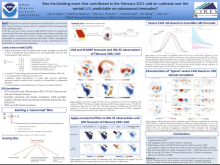Was the blocking event that contributed to the February 2021 cold air outbreak over the central U.S. predictable on subseasonal timescales?
John
Albers
NOAA Physical Sciences Laboratory
Poster
The sources of predictability for the February 2021 cold air outbreak (CAO) over the central United States, which led to power grid failures and water delivery shortages in Texas, are diagnosed using a machine learning–based prediction model called a linear inverse model (LIM). The LIM presented here, which is similar to a version developed to run in real-time for the NOAA CPC Weeks 3-4 temperature outlook, was able to predict some portion of the 2021 CAO up to four weeks in advance and identify the dynamical processes responsible for the predictable and unpredictable portions of the event.
We use a ‘nonnormal’ filter derived from the LIM to identify the dynamical modes of climate variability responsible for the CAO. These include a set of eigenmodes that capture forcing by tropical SSTs and interactions with the stratosphere (notably including the effects of the 2020-2021 La Niña event), a downward propagating stratospheric eigenmode (capturing the effects of sudden stratospheric warmings), the Madden-Julian oscillation, and a group of eigenmodes representing atmospheric internal variability. When the LIM’s nonnormal filter is applied to the CAO, it is shown that the cold surge was due primarily to SST-stratosphere based teleconnections and a blocking anticyclone over the North Pacific, with small cold anomaly contributions from the MJO and the early January sudden stratospheric warming. The extreme nature of the CAO was not completely predictable on subseasonal time scales, due to the large cold contribution from the blocking anticyclone that was not predicted by the LIM or operational numerical forecast models until 10–14 days prior to the onset of the event. Nevertheless, the tropically forced teleconnections (which contributed to the North Pacific blocking) were predictable 3-4 weeks in advance and both the stratospheric sudden warming and MJO contributions were also reasonably predictable on subseasonal timescales.
We use a ‘nonnormal’ filter derived from the LIM to identify the dynamical modes of climate variability responsible for the CAO. These include a set of eigenmodes that capture forcing by tropical SSTs and interactions with the stratosphere (notably including the effects of the 2020-2021 La Niña event), a downward propagating stratospheric eigenmode (capturing the effects of sudden stratospheric warmings), the Madden-Julian oscillation, and a group of eigenmodes representing atmospheric internal variability. When the LIM’s nonnormal filter is applied to the CAO, it is shown that the cold surge was due primarily to SST-stratosphere based teleconnections and a blocking anticyclone over the North Pacific, with small cold anomaly contributions from the MJO and the early January sudden stratospheric warming. The extreme nature of the CAO was not completely predictable on subseasonal time scales, due to the large cold contribution from the blocking anticyclone that was not predicted by the LIM or operational numerical forecast models until 10–14 days prior to the onset of the event. Nevertheless, the tropically forced teleconnections (which contributed to the North Pacific blocking) were predictable 3-4 weeks in advance and both the stratospheric sudden warming and MJO contributions were also reasonably predictable on subseasonal timescales.

Poster file
Meeting homepage
